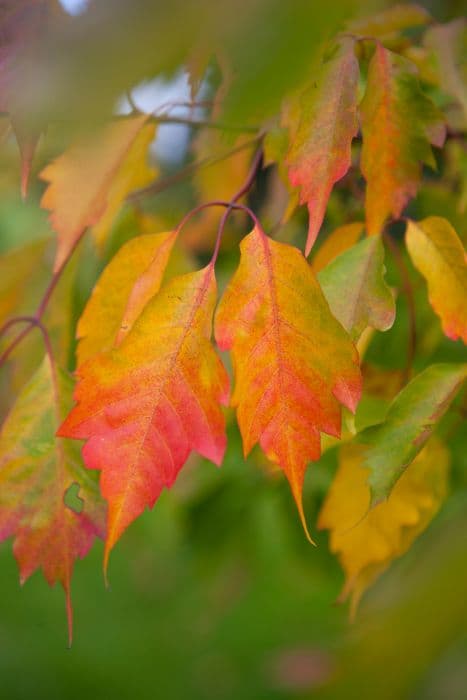Variegated Japanese Maple Acer palmatum 'Asahi-zuru' (P/v)
ABOUT
The Japanese maple 'Asahi-zuru' displays a striking appearance with a blend of colors and textures that can catch any plant lover's eye. This ornamental variety showcases an array of leaf colors throughout the seasons. Its foliage emerges in the spring with a brilliant variegation of pink, white, and green. This unique combination of colors gives the leaves a painterly quality, as if brushed with soft pastel hues among the green canvas. As the seasons transition, the leaves of the 'Asahi-zuru' Japanese maple may shift in color intensity but commonly retain some of their variegation. During the warmer months, the leaves may develop more green, providing a lush, lively appearance, while the pink and white tones might become more subtle. Come fall, the foliage may transform again, often presenting a different palette of colors including vibrant reds and oranges that are typical of Japanese maples, creating a spectacular autumn display. The leaf shape is another enchanting characteristic of the 'Asahi-zuru' Japanese maple. Each leaf is delicately lobed, resembling the palm of a hand with elongated fingers, which is referenced in its name 'palmatum'. This deeply dissected leaf structure lends a fine texture to the plant, creating a soft, feathery look that gracefully moves with the breeze. The branching structure of 'Asahi-zuru' is somewhat open and layered, giving it a graceful, spreading habit. These branches are often adorned with the beautiful tri-color foliage, and the contrast between the leaves and the bark can be quite striking, especially during the winter months when the leaves have fallen, leaving behind the elegant silhouette of bare branches. Overall, the 'Asahi-zuru' Japanese maple's attractiveness lies in its ever-changing colors, its finely dissected foliage, and its elegant growth habit, making it a prized specimen in any garden where seasonal variations in appearance are cherished.
About this plant
 Names
NamesSynonyms
Rising Sun Maple, Asahi-zuru Japanese Maple
Common names
Acer palmatum 'Asahi-zuru'
 Toxicity
ToxicityTo humans
The Japanese maple is not known to be toxic to humans. Ingesting parts of this plant typically does not lead to any severe symptoms or consequences. However, like with any plant material, individual allergies or sensitivities could cause mild irritation or discomfort if ingested.
To pets
Like their toxicity to humans, Japanese maples are generally not toxic to pets. Ingesting this plant is unlikely to result in serious poisoning or severe symptoms in animals. Pets that consume plant material might experience mild gastrointestinal upset, but significant toxic effects are not expected with this species. It's always good practice, though, to prevent pets from eating plants to avoid any potential issues or unforeseen reactions.
 Characteristics
CharacteristicsLife cycle
Perennials
Foliage type
Deciduous
Color of leaves
Variegated
Height
15-25 feet (4.6-7.6 meters)
Spread
15-25 feet (4.6-7.6 meters)
Plant type
Tree
Hardiness zones
5-9
Native area
Japan
Benefits
 General Benefits
General Benefits- Visual Appeal: 'Asahi-zuru' or Japanese Maple, offers ornamental value with its distinctive and colorful variegated foliage that changes throughout the seasons.
- Landscape Versatility: This plant can be used in a variety of landscape designs, including as a focal point, in containers, or as part of a mixed border.
- Shade Tolerant: It is capable of growing well in partially shaded areas, providing design flexibility in gardens with varying light conditions.
- Compact Size: With a relatively small size compared to other trees, it is suitable for smaller gardens or limited spaces.
- Seasonal Interest: Offers year-round interest with its spring flowers, summer leaf color, autumn foliage changes, and interesting branch patterns in winter.
- Wildlife Support: It can provide habitat and food sources for birds and beneficial insects.
- Low Maintenance: Requires minimal pruning and care once established, which is advantageous for gardeners seeking low-maintenance plants.
- Climate Adaptability: Acer palmatum 'Asahi-zuru' can adapt to a range of climate conditions within its hardiness zones.
 Medical Properties
Medical PropertiesThis plant is not used for medical purposes.
 Air-purifying Qualities
Air-purifying QualitiesThis plant is not specifically known for air purifying qualities.
 Other Uses
Other Uses- Craft Materials: The colorful leaves of Acer palmatum 'Asahi-zuru' can be used in dried leaf art projects or to create natural dyes for fabrics.
- Photography Subject: With its variegated foliage, this plant is often used by photographers as a subject for botanical photography or as a background to enhance composition.
- Landscape Design Teaching Tool: Due to its distinctive appearance, it may be used in educational settings to teach about plant variegation and landscape design aesthetics.
- Bonsai Specimen: Acer palmatum varieties are popular in the art of bonsai; 'Asahi-zuru's unique foliage can make an attractive and unusual bonsai.
- Seasonal Decorations: The branches and leaves can be used to create natural and biodegradable decorations for fall or spring-themed events.
- Meditation Gardens: This plant is commonly included in Zen and meditation gardens where its calming presence can be contemplated.
- Thematic Gardening Inspiration: The 'Asahi-zuru' can act as a central theme for a garden, inspiring a collection that revolves around variegated or uniquely patterned plants.
- Culinary Garnish: While not typically consumed, the leaves can be used as a temporary, decorative garnish for plating high-end dishes in culinary presentations.
- Artistic Reference: Artists may use this plant as a reference for paintings, illustrations, or designing patterns inspired by its variegated leaves.
- Symbolism and Gifts: Because of their beauty, these trees can be gifted symbolically to represent endurance and grace, as the Japanese maple is often admired for its ability to thrive in changing conditions.
Interesting Facts
 Feng Shui
Feng ShuiThe Japanese Maple is not used in Feng Shui practice.
 Zodiac Sign Compitability
Zodiac Sign CompitabilityThe Japanese Maple is not used in astrology practice.
 Plant Symbolism
Plant Symbolism- Beauty and Elegance: The Acer palmatum 'Asahi-zuru', commonly known as the variegated Japanese Maple, is often associated with beauty and elegance due to its intricate foliage patterns and graceful growth habit.
- Change and Transformation: As a deciduous tree known for its striking autumn colors, it symbolizes the changing seasons and the natural cycle of growth and transformation.
- Peace and Tranquility: The Japanese Maple is commonly found in serene settings like Japanese gardens, where it represents peace and tranquility due to its calming presence.
- Balance and Harmony: The balanced, symmetrical growth of the Japanese Maple, along with its soothing appearance, represents the desire for balance and harmony in life.
- Endurance and Longevity: Despite its delicate appearance, the Japanese Maple is a hardy tree that can endure through adverse conditions, symbolizing endurance and the ability to withstand the challenges of time.
 Water
WaterThe Japanese Maple 'Asahi-zuru' prefers consistent moisture without being waterlogged. It should be watered deeply once a week, providing about 1.5 gallons per watering for a young tree, increasing as the tree matures and the root system expands. During hot or dry periods, you may need to water twice weekly, particularly if the leaves show signs of wilting or scorching. Make sure to water directly at the base of the tree, avoiding overhead watering to prevent leaf diseases. Always allow the soil surface to dry out slightly between waterings to prevent root rot.
 Light
LightJapanese Maples like 'Asahi-zuru' thrive best in dappled sunlight or partial shade. They can tolerate full sun conditions, but in particularly hot climates or during the peak of summer, some afternoon shade is beneficial to prevent leaf scorch. The ideal spot for 'Asahi-zuru' is where it receives morning sunlight and protection from the intense midday and afternoon sun.
 Temperature
TemperatureThe 'Asahi-zuru' Japanese Maple fares well in a range of temperatures and can survive minimum winter temperatures down to -20 degrees Fahrenheit. Ideally, they enjoy a climate where temperatures are between 60 to 80 degrees Fahrenheit. They can tolerate summer heat up to about 90 degrees Fahrenheit, but beyond that, some protection or additional watering may be necessary to keep the tree healthy.
 Pruning
PruningPrune 'Asahi-zuru' Japanese Maple to maintain a harmonious shape and remove any dead, damaged, or diseased branches. The best time for pruning is late winter or early spring before new growth starts. Light pruning can be done throughout the growing season to remove unwanted branches. Pruning is usually done annually, but extensive pruning should be spaced several years apart.
 Cleaning
CleaningAs needed
 Soil
SoilJapanese Maple 'Asahi-zuru' thrives in a well-draining soil mix with good organic content. A blend of one part peat, one part pine bark, and one part coarse sand or pumice is ideal. The soil pH should be slightly acidic, ranging from 5.5 to 6.5 for optimal growth.
 Repotting
RepottingThe Asahi-zuru Japanese Maple should be repotted every 2-3 years when young, and less frequently as it matures, possibly every 4-5 years. Repotting is best done in late winter or early spring before the growing season starts.
 Humidity & Misting
Humidity & MistingAsahi-zuru Japanese Maple prefers average to high humidity levels. While it can tolerate some dryness, maintaining humidity around 50-60% is beneficial for the plant's health and vigor.
 Suitable locations
Suitable locationsIndoor
Place in bright, indirect light and ensure humid conditions.
Outdoor
Plant in dappled shade with shelter from harsh winds.
Hardiness zone
5-8 USDA
 Life cycle
Life cycleThe life of the Japanese Maple 'Asahi-zuru' begins with seed germination, where the seeds require stratification to break dormancy before they sprout. After sprouting, the seedlings grow through the juvenile phase, gradually developing their distinctive palmate leaves with variegated patterns of pink, white, and green. As the sapling matures, it enters the vegetative stage, focusing on expanding its root system and canopy size for several years. Upon reaching maturity, the Japanese Maple 'Asahi-zuru' begins its reproductive stage, producing small reddish-purple flowers in spring which, if successfully pollinated, give way to winged samaras, or 'helicopter seeds', that disperse in the wind. The tree then goes through a yearly cycle of growth, where leaves emerge in spring, provide energy through photosynthesis in the summer, and turn vibrant colors before being shed in the fall. The life cycle continues as it enters a period of dormancy in the winter, preserving energy until the next growing season commences.
 Propogation
PropogationPropogation time
Spring-Early Summer
The Japanese maple 'Asahi-zuru' is often propagated by grafting, which is the most popular method for reproducing this ornamental plant due to its reliability in replicating the distinct variegation of the leaves. Grafting is usually performed in late winter or early spring before the sap begins to flow. A piece of the Acer palmatum 'Asahi-zuru', typically a bud or shoot, is joined onto a rootstock of a different maple species that is known for its hardiness and vigor. The graft union is then wrapped to protect it and kept moist until the graft has taken, which can be verified by the growth of new shoots from the grafted material. This method preserves the characteristics of the 'Asahi-zuru' while potentially enhancing disease resistance and adaptability through the rootstock.









